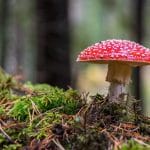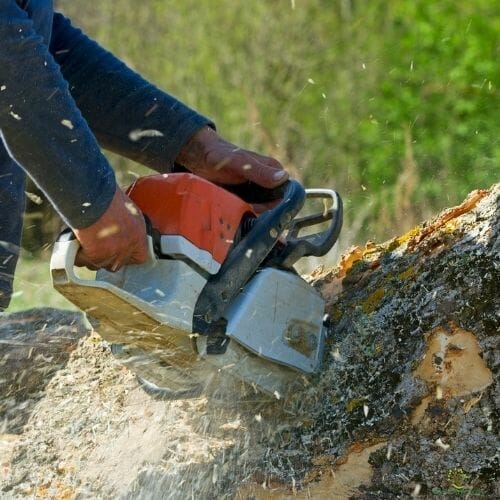How Conks And Mushrooms Grow On Trees In Austin
When mushrooms or conks, also referred to as a bract or shelf, sprout on tree bark, it’s typically a symptom that the tree is diseased with a fungus that causes decay. Although not all mushrooms are dangerous to trees, a large number of them are. They produce heart decay, causing healthy trees to rot at the trunk’s core.
These fungi penetrate the tree through wounds created by poor pruning, lightning, windstorms, fire, building, or other tree damage. Fruiting bodies, or conks, form in old wounds, bark cracks, and branch stubs, and the decay fungi proliferate through them. Animals, insects, water, and wind transport spores from these fruiting bodies to other trees. These spores settle in a tree wound and spread the fungus all over the place.
White rot, brown rot, soft rot, and varnish rot are among the different types of heart rot. Some are more harmful to the tree than others. The best defense against any of the different heart rots invading your trees is to prevent tree wounds.
White Rot
White rot organisms decompose the lignin and cellulose in the wood, making it feel fragile and stringy, damp and spongy. The wood seems to be white or yellow. More than 75 species of trees are affected by white rot caused by the split-gill mushroom. Pine, fir, spruce, sequoia, acacia, ash, locust, willow, magnolia, birch, ash, laurel, oak oleander, and poplar are among these trees. Artist’s conk is a white and brown shelf mushroom that can be found in citrus trees, as well as pine, fir, maple, elm, and poplar.
Varnish fungus, a brilliant red conk, can damage landscape and fruit trees in 3 to 5 years. Pine, fir, poplar, and willow trees, as well as apple, cherry, peach, and citrus trees, are all susceptible. On oak and maple trees, deterioration occurs quickly. The conks have a varnish-like layer on top and can develop up to 14 inches wide. They normally appear at the foot of a tree in the summer.
Spruce, fir, holly, tulip tree, willow, maple, pecan, walnut, persimmon, chestnut, eucalyptus, hackberry, alder, beech, acacia, linden, magnolia, oak, poplar, ash, birch, and willow are among the trees affected by oyster mushrooms, which cause a white, flaky rot. The oyster mushroom is a shelf-like mushroom that grows from 2 to 8 inches across and has gills on the bottom.
Brown Rot
Brown rot, also known as dry rot, is caused by a fungus that feeds on hemicelluloses, leaving behind the brownish-coloured lignin. Due to the transverse and longitudinal fissures in the wood, brown rot destroys dry wood, causing it to crumble into cubes. Through the wood, a single rot column forms. Brown rot mushrooms grow rapidly and are more harmful than white rot mushrooms.
When sulfur mushrooms are young, they are orange-yellow on top and red-orange on the bottom. They turn white as they get aged. They are targeting eucalyptus, maple, poplar, oak, walnut, yew, chestnut, birch, ash, pine, spruce, and cherry trees, among others. One of the most serious causes of rot in oaks is the sulfur mushroom fungus, which is one of the few fungi that destroys yew trees. They range in size from 6 to 12 inches across and are soft and wet.
In mature oak, chestnut, and other hardwoods, a reddish-brown, thick beefsteak fungus causes serious brown rot. The appearance of the red-banded polypore differs, but it commonly includes a red band at the conk’s bottom edge. Coniferous trees are its preferred prey.
Soft Rot
Soft rot is caused by both fungus and bacteria. They eat cellulose, hemicellulose, and lignin, but only in the places where they’re growing. Soft rots take longer to develop than white or brown rots.
Fungi are disseminated via the air by spores that adhere to old wounds or injuries. Fire, ice, improper pruning, damaged branches, lightning, and burrowing insects can all create tree wounds.
Fungus Is Caused By A Variety of Factors.
Mycelia, the vegetative component of fungi, are found between the wood and bark of roots and the part of the trunk that is below the soil level when tree bark is taken off. Mushrooms grow beneath the soil at the foot of the damaged tree after the winter rains. They thrive in damp environments, but will not thrive in dry ones. Simply removing the damp dirt from around the base of the tree and allowing it to dry out will sometimes help to reduce or even stop rotting.
Fungi That Grow on Trees
The colour, shape, and texture of the conks that form on the trees can help identify many of the fungi mentioned above. Fruiting bodies are frequently seen near wounds, scars, and the root crown. The oyster mushroom and the golden-brown honey mushroom, for example, are edible mushrooms. Just make sure you know what kind of mushroom you’re eating because some can make you sick or even kill you.
Mushrooms And Conks Prevention
Once the spores have made their home in a tree, there isn’t much a person can do. They usually target older trees or those that have been injured in some way. You can chop the branch off if the mushroom is developing on it. Make careful to leave a collar around the wound when you’re done. Never, ever, ever leave a stub.
Fungus Poses a Risk of Tree Falling
Trees that have been affected with heart rot by these fungi, particularly those infected with brown rot, become weaker. A strong wind, especially one that comes after several days of rain, might topple a tree that has been weakened by decay. Of course, everybody or anything in its path is in peril. If you have a tree that has been affected by the disease, you should either get it removed by a professional or secure it with braces or wires.
Read more to learn about tree disease and pest control here. For more information, contact West Austin Trees Services.

















